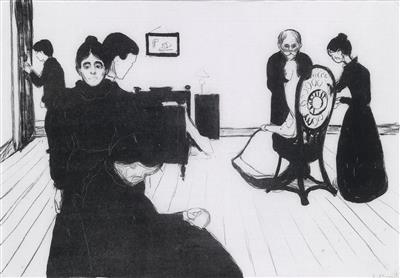Edvard Munch *

(Loeiten 1863–1944 Oslo) Death in the Sickroom, signed E. Munch, lithograph on fine Japan paper, image size 38.5 x 56 cm, sheet size 39.5 x 56 cm, Druck Clot, Lassally, Nielsen, Woll 65c, framed, (PS)
Edvard Munch wrote in his Saint-Cloud diary in 1889: “There will be no more painting of interior scenes, no people reading and women knitting, instead living people, who breathe, feel, suffer and love.” His insistence on making the subject of his paintings emotional, meaningful and anti-naturalist found great favour among artist colleagues such as Gauguin, Hodler and Ensor, whilst meeting with total incomprehension amongst impressionist painters. Observation of his work shows clearly that emotional figures express emotional moods, the figures themselves significant not as individuals, but rather as vehicles for the expression of their psychological state. The grief, the helplessness and the trepidation in this room of death are embodied in the visual depiction of the individuals’ state of mind. Munch’s total concentration is focused on the faces of the mourners; their clothing and hair executed in an almost uniform black. The woman sitting in the rocking chair, her face indiscernible to the viewer, only becomes visible in the outline of her clothing and in the man supporting her, and standing in front of her. Edvard Munch knew how to portray the innermost secrets of human life, (lost) love, loneliness, illness and anger, with extreme calm and with minimal artistic means.
Expert: Dr. Petra Maria Schäpers
 Dr. Petra Maria Schäpers
Dr. Petra Maria Schäpers
petra.schaepers@dorotheum.de
15.05.2013 - 19:00
- Odhadní cena:
-
EUR 50.000,- do EUR 60.000,-
Edvard Munch *
(Loeiten 1863–1944 Oslo) Death in the Sickroom, signed E. Munch, lithograph on fine Japan paper, image size 38.5 x 56 cm, sheet size 39.5 x 56 cm, Druck Clot, Lassally, Nielsen, Woll 65c, framed, (PS)
Edvard Munch wrote in his Saint-Cloud diary in 1889: “There will be no more painting of interior scenes, no people reading and women knitting, instead living people, who breathe, feel, suffer and love.” His insistence on making the subject of his paintings emotional, meaningful and anti-naturalist found great favour among artist colleagues such as Gauguin, Hodler and Ensor, whilst meeting with total incomprehension amongst impressionist painters. Observation of his work shows clearly that emotional figures express emotional moods, the figures themselves significant not as individuals, but rather as vehicles for the expression of their psychological state. The grief, the helplessness and the trepidation in this room of death are embodied in the visual depiction of the individuals’ state of mind. Munch’s total concentration is focused on the faces of the mourners; their clothing and hair executed in an almost uniform black. The woman sitting in the rocking chair, her face indiscernible to the viewer, only becomes visible in the outline of her clothing and in the man supporting her, and standing in front of her. Edvard Munch knew how to portray the innermost secrets of human life, (lost) love, loneliness, illness and anger, with extreme calm and with minimal artistic means.
Expert: Dr. Petra Maria Schäpers
 Dr. Petra Maria Schäpers
Dr. Petra Maria Schäpers
petra.schaepers@dorotheum.de
|
Horká linka kupujících
Po-Pá: 10.00 - 17.00
kundendienst@dorotheum.at +43 1 515 60 200 |
| Aukce: | Moderní |
| Typ aukce: | Salónní aukce |
| Datum: | 15.05.2013 - 19:00 |
| Místo konání aukce: | Wien | Palais Dorotheum |
| Prohlídka: | 04.05. - 15.05.2013 |
